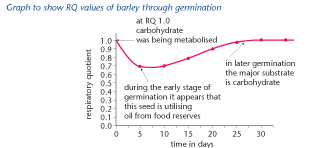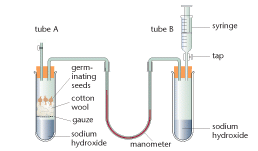Respiratory quotient
It is sometimes useful to be able to deduce which substrate is being used in a person’s metabolism at a specific time. This can be done if the volume of oxygen taken in, and the volume of carbon dioxide given out are measured. From this data the respiratory quotient (RQ) can be calculated.
RQ = volume of carbon dioxide given off
volume of oxygen taken in
The RQ values of the following substrates are well documented from previous investigations:
carbohydrate 1.0; protein 0.9; fat 0.7
It is interesting to know which substrate is being metabolised. It is necessary to view such data with caution. If a mixture of substrates is being used then the figure will be different from the above, e.g. an RQ of 0.8 could point to both protein and fat being used.
The graph below shows the different RQ values of a seed during different stages of germination.

Take great care in interpreting RQ data. This graph suggests that the seed begins with carbohydrate as a metabolite, changes to fat/oil then returns to mainly using carbohydrate. Any RQ
which is not of the numbers given suggests a substrate combination is being used.
How is the RQ data collected?
The instrument called a respirometer, does this.

- Sodium hydroxide absorbs all CO2 from the air in the apparatus from the beginning. Potassium hydroxide could be used instead of sodium hydroxide. They both absorb CO2.
- As the germinating seeds use oxygen and the pressure reduces in tube A so the manometer level nearest to the seeds rises.
- Any CO2 excreted is absorbed by the sodium hydroxide solution.
- The syringe is used to return the manometer fluid levels to normal.
- The volume of oxygen used is calculated by measuring the volume of gas needed from the syringe to return the levels to the original values.
If water replaces the sodium hydroxide then the carbon dioxide evolved can be measured.
